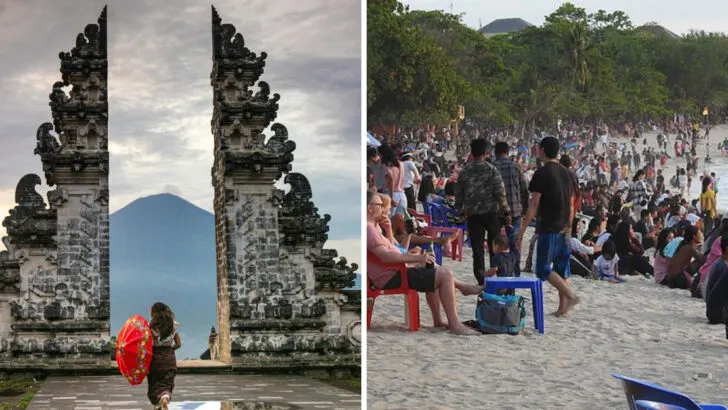Bali, once a paradise for travelers seeking tranquility, is now grappling with the effects of overcrowding.
These signs reveal how the island’s charm is being overshadowed by the burgeoning influx of visitors.
Traffic Gridlock Is the New Normal
Imagine the thrill of navigating Bali’s winding roads with the wind in your hair. That joy is now replaced by frustration as gridlock grips areas like Canggu and Seminyak. Commuting times have doubled, leaving residents and tourists alike stuck in bumper-to-bumper traffic.
Once, a leisurely scooter ride was a symbol of freedom. Now it has become a test of patience. The sheer volume of vehicles is overwhelming infrastructure, leading to long delays and pollution.
Locals reminisce about the days when getting around was effortless. This new norm is a stark reminder of the island’s growing overcrowding.
Overdevelopment Has Stripped Away Natural Beauty
Once upon a time, Bali was a canvas of lush rice paddies and dense jungles. Today, that picture is marred by relentless construction. Luxury villas and beach clubs now dominate the landscape, replacing nature’s masterpieces with concrete edifices.
The skyline, once dotted with palms, is now cluttered with cranes. Local ecosystems are disrupted, and traditional village life is fading. This shift is not just physical but cultural, as modernity encroaches on heritage.
The island is at a crossroads, grappling with the price of progress. The scars of overdevelopment are painfully visible.
Water Shortages Are Affecting Locals
Bali’s allure lies in its paradisiacal image, but even paradise has its struggles. Water shortages are an ironic twist for an island surrounded by ocean. Rapid tourism growth has strained resources, leaving rural communities without sufficient water.
Resorts and villas consume vast quantities, causing groundwater levels to plummet. Villagers face dry taps and dusty fields, unheard of just a few years ago. This scarcity impacts daily life, from cooking to farming.
The imbalance highlights the urgent need for sustainable practices, as Bali navigates this critical challenge.
Waste Management Can’t Keep Up
Bali’s waste woes are as alarming as they are visible. The island produces over 1,500 tons of waste daily, overwhelming current management systems. Rivers clogged with debris and open burning of trash paint a grim picture.
This environmental crisis affects both health and the island’s natural beauty. Beaches once pristine now bear the brunt of this overflow. Local initiatives struggle to combat the deluge, highlighting gaps in infrastructure. The problem is not just about waste but the larger issue of unchecked growth.
Bali must redefine its relationship with consumption and disposal.
Iconic Beaches Are Losing Their Charm
The allure of Bali’s beaches is legendary, yet the reality is shifting. Tourists flock in droves, transforming serene stretches into bustling hubs. Litter, particularly plastic, mars the golden sands.
The pristine image is fading fast, replaced by crowded scenes. Peak seasons exacerbate the chaos, with barely a spot to lay a towel. Efforts to clean up are ongoing, but the tide of tourists continues unabated.
This loss of charm is felt by both locals and visitors seeking solace. The beaches, once a symbol of escape, now mirror the island’s overcrowded reality.
Local Culture Is Being Commercialized
Bali’s cultural heart beats with rituals and traditions, yet commercialization threatens its essence. Traditional ceremonies, once sacred, are now often staged for tourists.
The authenticity of Balinese dances and rituals risks being diluted. Visitors seek an exotic experience, yet the reality is a curated performance. Local artisans and performers navigate this complex landscape, balancing tradition with tourism.
This commercial shift impacts the island’s spiritual core, leading to debates about cultural preservation. The challenge is finding harmony between honoring heritage and embracing visitors.
Sacred Sites Are Overrun with Tourists
Sacred sites like Tanah Lot and Lempuyang are more than tourist attractions. They are sanctuaries, yet are now swamped with visitors seeking the perfect photo op. The spiritual atmosphere is disrupted by the sheer number of tourists, creating chaos in places meant for reflection.
This influx challenges the balance between accessibility and preservation. Local authorities grapple with maintaining these sites’ sanctity amid popularity. Visitors often overlook the cultural significance, focusing instead on capturing a moment.
The impact is a poignant reminder of the challenges Bali faces.
Cost of Living Is Rising for Locals
Bali’s appeal as a hub for digital nomads and luxury seekers has a hidden cost. The influx of wealth has driven up real estate prices, affecting locals. Everyday costs, from groceries to rent, have surged, stretching budgets thin.
Many residents are being priced out of their own communities. This economic shift creates a divide between new arrivals and long-time residents. The island’s growth story is also one of displacement, as locals navigate a changing landscape.
The rising cost of living highlights broader socio-economic challenges for Bali’s future.
Housing Crisis Driven by Short-Term Rentals
Platforms like Airbnb are reshaping Bali’s housing market, with significant consequences. The surge in short-term rentals reduces long-term housing availability, inflating costs for residents. This trend pushes locals out of traditional neighborhoods, as properties cater to transient visitors.
The landscape is changing, with communities and cultures destabilized by economic pressures. Homeowners find lucrative opportunities in short-term leases, yet the broader impact is concerning.
The housing crisis reflects the need for regulatory measures to balance tourism with community needs. Bali’s identity is at stake, caught in this rental tug-of-war.
Wildlife Is Disappearing from Tourist Zones
Bali’s rich biodiversity is under siege from urban expansion. Native wildlife retreats as natural habitats transform into tourist zones. Deforestation and development encroach on once-thriving ecosystems, leading to a decline in species diversity.
The island’s iconic flora and fauna are increasingly rare sights near populated areas. Conservation efforts strive to protect these treasures, yet the reality is challenging. As humans push boundaries, nature suffers.
This ecological imbalance is a stark reminder of the consequences of growth. Bali’s wildlife story is one of resilience amidst adversity, a call for sustainable interaction.
Tourist Behavior Is Increasingly Disrespectful
Tourism, while beneficial, brings challenges, notably disrespectful behavior. Instances of temple desecration and nudity on sacred mountains are escalating. This lack of cultural sensitivity sparks public outrage and prompts stricter regulations.
The disrespect disrupts local customs, offending residents and spiritual leaders. Educational efforts aim to inform visitors about appropriate conduct, yet issues persist. This clash highlights the need for cultural awareness in tourism.
The island’s identity is intertwined with spirituality and tradition, and maintaining this balance is crucial. Bali’s cultural fabric depends on mutual respect and understanding.
Strained Infrastructure and Frequent Power Outages
Bali’s infrastructure struggles to meet growing demands. Frequent power outages and unreliable internet service frustrate residents and tourists. Sewage leaks and overburdened roads further highlight the strain.
The island’s rapid development outpaces its infrastructure capabilities, leading to disruptions in daily life. Efforts to upgrade systems are ongoing, yet challenges remain. This imbalance affects the quality of life and visitor experience.
Infrastructure development is essential for supporting Bali’s growth and preserving its allure. Without it, the island risks losing its appeal as a top destination.
Locals Are Calling for a Tourism Slowdown
Amid Bali’s transformation, many locals advocate for a tourism slowdown. Activists and community leaders voice concerns about unsustainable growth. They call for models that prioritize the island’s ecological and cultural integrity.
Visitor caps and sustainable practices are proposed solutions to preserve Bali’s charm. The movement reflects growing awareness of the island’s limits. Government officials are beginning to acknowledge these concerns, exploring policies for balance.
This call to action emphasizes the importance of sustainability in tourism. Bali’s future hinges on harmonizing visitor influx with preservation efforts.

